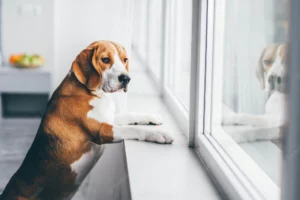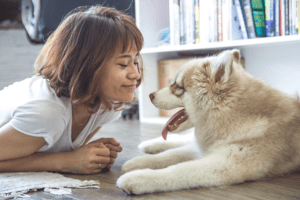Longlivedog.com – When you bring a new puppy home, you’re bound to have some troubleshooting to do. But some of the most common puppy problems can easily be avoided if you know about them in advance. This blog post will discuss the three biggest puppy problems and offer solutions for each. These tips will help you get your new dog off to a smooth start, from potty training to chewing furniture.
Puppy biting
Puppies are adorable little creatures and can be a lot of fun. However, sometimes they can be naughty and bite people or other animals. Puppy biting is a problem that needs to be dealt with as quickly as possible so that it doesn’t escalate. Here are the five biggest puppy problems and the solutions:
- Aggression Towards Other Pets or People: If your puppy is constantly aggressive towards other pets or people, you might need help from a professional trainer. This could involve teaching your puppy basic obedience commands and some behavioral modification techniques.
- Destruction of Property: If your puppy is constantly destroying things in the house, this might also be an indication of behavioral issues that need to be addressed by a professional trainer. Your puppy might not be able to control its aggression or destructive impulses, so you’ll need to work with them on this issue too.
- Resisting Feeding Time: If your puppy is resistant to being fed, this could mean that he’s bored or upset. You should try different kinds of foods and see if that helps calm him down enough for feedings to take place peacefully.
- Destroying Things Indoors: Another common behavior problem among puppies is destroying things inside the home – usually furniture or toys. This needs to be corrected immediately if it’s going to continue until there’s nothing left in the house!
- Biting People:
Potty training a puppy
When you bring your new puppy home, one of the things you’ll need to do is teach her how to use the potty. A potty-trained puppy can go without an accident for a more extended period and be more comfortable overall.
Many different methods can be used when potty training a puppy, but the most important thing is to stick with it and provide consistency. Here are some of the biggest puppy problems and the solutions:
1. Not knowing where the potty is
The first step in teaching your puppy to use the potty is having her learn where it is. Every dog is different, but most puppies need somewhere they can go when they have an accident. If there’s nowhere designated as a potty, your pup may start relieving herself wherever she feels like it – which could lead to accidents all over the house.
Before letting her out, have your pup sit beside you and show her where the potty is. Once familiar with it, move it around, so she can avoid getting too attached to one spot. It’s also important to remember that puppies under six months old don’t really understand what toileting means yet, so don’t expect her to go on command. Wait until she’s about eight weeks old before really starting training her.
Housebreaking your puppy
You can do a few things to help prepare your puppy for a new home before they are brought in. Consider some house-breaking tips if your puppy needs to do better.
Puppy housebreaking should start as soon as your puppy can move around independently. Some puppies learn very early on, while others take longer. An excellent way to determine when your puppy is ready to potty outside is watching them when they are allowed freedom in their crate or kennel area. When they start eliminating outside the designated area, it is time to begin housetraining.
Begin by providing lots of positive reinforcement when your puppy goes potty outside and remove any toys or treats that might encourage the behavior of going to mess inside. Do this consistently and gradually increase the time you leave your pup free before returning them indoors. Be patient – it may take several weeks for your puppy to housetrain completely!
If your puppy has had previous difficulties with pottying outside, consult a professional who can help develop a plan specific to your pet’s needs. Following through with proper training will go a long way in ensuring that your puppy breaks housebreaking habits quickly and easily! Many effective products on the market can also be used during exercises, such as pee pads and training collars.
Separation anxiety in puppies
Puppies are cute and cuddly, but they also have a lot of energy and can be jumpy when new. This is part of their personality, but it can also signify their feeling anxious or scared.
Some common signs of separation anxiety in puppies include being clingy, not wanting to leave your side, incessant barking or whining, and destructive behavior. If you notice any of these behaviors in your puppy, there are some things you can do to help him feel better.
One important thing to remember is that puppies need time to adjust to changes, including being separated from their mom or dad. It would help if you took your puppy on regular walks so he gets used to being away from you for a little while and gradually introduces more people and situations into his life until he’s comfortable with them. Be patient; it may take several weeks for him to overcome his fear of separation.
Destructive chewing
It can be hard to know when your puppy is chewing things destructively. But there are a few telltale signs that you should watch out for. Here are the three most common destructive chewing habits in puppies:
- Chewing on non-food items such as couches, chairs, or rugs.
- Destroying toys or furniture.
- Biting or scratching furniture or walls excessively.
If you notice any of these behaviors in your pup, it’s time to take action! Start by ensuring he has plenty of chew toys and other items to play with and keep his environment safe from potential chew hazards. See a behaviorist if he continues to exhibit destructive chewing tendencies, as this may indicate other underlying problems that need to be addressed.
Shyness in puppies
Shyness in puppies can be a very frustrating problem to deal with. It can make training complex, and it can be challenging for the puppy to socialize appropriately. There are a few things that you can do to help ease the shyness of your puppy.
One thing that you can do is to start training early. Puppies learn best when they are actively engaged in their training. This will help them build confidence and learn how to interact appropriately with other people and animals.
Another thing that you can do is to provide plenty of positive reinforcement for good behavior. This will help your puppy feel happy and confident, encouraging them to socialize more freely.
Conclusion
Puppies are the best things in the world, but like any other new addition to your family, they can also be prone to common problems. This article will discuss a few of the most common puppy problems and how you can solve them. From potty training to chew-related issues, our tips will help keep your pup happy and healthy!








